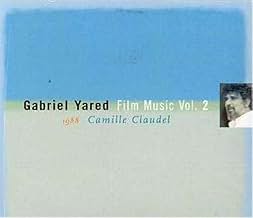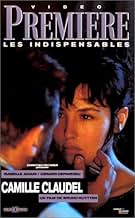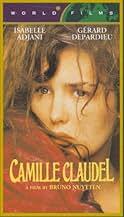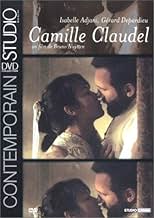VALUTAZIONE IMDb
7,3/10
7742
LA TUA VALUTAZIONE
Camille Claude fa colpo sul già famoso scultore Auguste Rodin. La assume come assistente, ma presto Camille inizia a scolpire per se stessa e diventa anche la sua amante. Ma dopo un po', vor... Leggi tuttoCamille Claude fa colpo sul già famoso scultore Auguste Rodin. La assume come assistente, ma presto Camille inizia a scolpire per se stessa e diventa anche la sua amante. Ma dopo un po', vorrebbe uscire dalla sua ombra.Camille Claude fa colpo sul già famoso scultore Auguste Rodin. La assume come assistente, ma presto Camille inizia a scolpire per se stessa e diventa anche la sua amante. Ma dopo un po', vorrebbe uscire dalla sua ombra.
- Regia
- Sceneggiatura
- Star
- Candidato a 2 Oscar
- 7 vittorie e 14 candidature totali
Recensioni in evidenza
This film is about the tragic failure of a genius. She fails not so much because of her tendency to make fatal mistakes but because of the shape those mistakes took in her mind. This, even as lesser personages prospered (e.g., Camille's brother Paul, the famous Catholic poet and diplomat) because they were not adverse to espousing convenient "beliefs" for the sake of earthly success. Many viewers will feel a strong affinity with Camille, not because they consider themselves geniuses but rather for the interior world she constructed that, without religion, gave the exterior world meaning. I say she was without religion, but in fact sculpture was her religion--at least until her final failure to gain the respect and patronage of capricious buyers. It was then that her religion (her meaningful myth) took the form of a conspiracy delusion. Powerful people, she thought (mostly, the sculptor Rodin, who had been her lover), were out to get her, thwarting her every move.
What we experience here is a thoughtful, scary exploration of the darkness that is a paradoxical part of all brilliance.
What we experience here is a thoughtful, scary exploration of the darkness that is a paradoxical part of all brilliance.
I couldn't take my eyes away from the television, and it wasn't because it was in French with English subtitles. This is a superbly acted film depicting two artists' work, passion, fears and ultimately her downfall, falling victim to her own creative mind.
Now that this wonderful story will be a Broadway musical in 2003 under the finesse of Frank Wildhorn and the magical voice of lovely Linda Eder, one will certainly appreciate familiarizing themselves with the background of the subject of this movie, Camille Claudel.
Now that this wonderful story will be a Broadway musical in 2003 under the finesse of Frank Wildhorn and the magical voice of lovely Linda Eder, one will certainly appreciate familiarizing themselves with the background of the subject of this movie, Camille Claudel.
10ULVAEUS
How the american academy award could have forgotten one of the best performance of an actress ? it's a total mystery! The talent of Isabelle ADJANI is not at all recognized as it deserves. She's absolutely poignant in this part, from the young Camille to the crackin'up mature sculptor falling in despair and madness. The scene where Rodin touch her art in the dark and leads him to a scene where their respective egos fight each other, discovering the deep scars let by their devastating passion is an highlight of acting. At his level, it can be compared to "sunset boulevard" or "a streetcar named Desire".
An exhibit of Rodin's sculptures was circling the Western United States a few years back. In any gallery in which they were exhibited they snapped heads; there are few figures that speak with such authority or superiority, mute testimony, like the Easter Island figures, to as much effort and skill. And so the movie `Camille Claudel', in like fashion, snaps heads in its understated power and commitment to craft.
Like Ansel Adams, Rodin stretched nature beyond what was possible they both showed us something that was not there and in the rendering made representations so striking they had no precedent and thus set the bar higher for subsequent generations of artists. As history played out, the far less well known sculptor Camille Claudel made substantial contributions but her tie to Rodin (and eventually her personal decline) for a period in the late nineteenth century is the focus in this instance. In truth, her story demanded to be filmed; she stands a remarkable artist and most importantly the passion, talent and influence (inarguably on Rodin) she possessed went well beyond the `colorful' label oft attached to the gifted.
Historically, this film is probably not a bad representation of how events turned in her life. There are many issues and turns, and years for that matter, the details of which remain unclear to this day. But in its entirety this is a marvelous interpretation of the record. And without doubt Isabelle Adjani was the right actor for the job.
Stunningly beautiful, there are few women in history as arresting as Isabelle is; certainly Camille was not as lovely, but the resemblance is darned good as compared to actors chosen to portray historical figures in most movies based on true events and the people that were part of them. That Adjani brings some of the passion is certain. After all, bizarre, or at least socially unacceptable, behavior resulted in her eventual incarceration, so we know she was a handful.
Many of the key points of her upbringing are addressed; her father's stern and inconsistent yet lovingly supportive position in her life (this is more forcefully impressed on us as the years progress); her mother's complete non-support and dismissal of all that Camille does; her relationship with her less understanding and conflicted brother. But it is the period when she meets and falls for Rodin (and he with her) and their consequent tumultuous affair runs its course that is actually the focus of the film.
Gérard Depardieu's contribution as Rodin is probably the best work he has done. He looks (Rodin was 40 when he met the 21 year old Camille) very much as Rodin did in this period of his life. His love for his work, Camille and promoting his own career are his passions. We are lead through the minefield of his own making (his inability to get off a dime and marry Camille is their eventual downfall) and we are not totally sympathetic to his behavior. But this is the stuff of real life; as Seneca said, all art is but imitation of nature and both his and her own work convey their conflicted convictions.
The musical score haunts us, as it should, right from the opening of the film. Almost never detracting, it instead correctly underscores certain points in the narrative; but it is the opening where we see Camille scooping clay from beneath a Parisian street (and this is a well-crafted sequence) where we feel the upsurge of powerful currents operating. The music heightens our interest as we determine exactly what we are seeing.
Other nice touches in the film include an occasion where Camille and Rodin together study a model on a turntable, spinning the model about as metaphor for the emotional maelstrom gathering momentum. We also see a great moment when Rodin is caressing Camille's face, intercut with shots of him working clay into an as yet unidentifiable sculpture.
What follows the breakup of Camille and Rodin is essentially a retrospective of the downslide of a remarkable talent. The story of Claudel's own diminishing output of work and the steady erosion of her inability to cope with reality is frightening in its telling. At a meeting with Rodin some time after they have parted company she remarks that she has changed, and offers that `Nothing that's monstrous is foreign to me'. And so she truly (and sadly) withdraws into a world of her own making.
Rating: Four Stars.
Like Ansel Adams, Rodin stretched nature beyond what was possible they both showed us something that was not there and in the rendering made representations so striking they had no precedent and thus set the bar higher for subsequent generations of artists. As history played out, the far less well known sculptor Camille Claudel made substantial contributions but her tie to Rodin (and eventually her personal decline) for a period in the late nineteenth century is the focus in this instance. In truth, her story demanded to be filmed; she stands a remarkable artist and most importantly the passion, talent and influence (inarguably on Rodin) she possessed went well beyond the `colorful' label oft attached to the gifted.
Historically, this film is probably not a bad representation of how events turned in her life. There are many issues and turns, and years for that matter, the details of which remain unclear to this day. But in its entirety this is a marvelous interpretation of the record. And without doubt Isabelle Adjani was the right actor for the job.
Stunningly beautiful, there are few women in history as arresting as Isabelle is; certainly Camille was not as lovely, but the resemblance is darned good as compared to actors chosen to portray historical figures in most movies based on true events and the people that were part of them. That Adjani brings some of the passion is certain. After all, bizarre, or at least socially unacceptable, behavior resulted in her eventual incarceration, so we know she was a handful.
Many of the key points of her upbringing are addressed; her father's stern and inconsistent yet lovingly supportive position in her life (this is more forcefully impressed on us as the years progress); her mother's complete non-support and dismissal of all that Camille does; her relationship with her less understanding and conflicted brother. But it is the period when she meets and falls for Rodin (and he with her) and their consequent tumultuous affair runs its course that is actually the focus of the film.
Gérard Depardieu's contribution as Rodin is probably the best work he has done. He looks (Rodin was 40 when he met the 21 year old Camille) very much as Rodin did in this period of his life. His love for his work, Camille and promoting his own career are his passions. We are lead through the minefield of his own making (his inability to get off a dime and marry Camille is their eventual downfall) and we are not totally sympathetic to his behavior. But this is the stuff of real life; as Seneca said, all art is but imitation of nature and both his and her own work convey their conflicted convictions.
The musical score haunts us, as it should, right from the opening of the film. Almost never detracting, it instead correctly underscores certain points in the narrative; but it is the opening where we see Camille scooping clay from beneath a Parisian street (and this is a well-crafted sequence) where we feel the upsurge of powerful currents operating. The music heightens our interest as we determine exactly what we are seeing.
Other nice touches in the film include an occasion where Camille and Rodin together study a model on a turntable, spinning the model about as metaphor for the emotional maelstrom gathering momentum. We also see a great moment when Rodin is caressing Camille's face, intercut with shots of him working clay into an as yet unidentifiable sculpture.
What follows the breakup of Camille and Rodin is essentially a retrospective of the downslide of a remarkable talent. The story of Claudel's own diminishing output of work and the steady erosion of her inability to cope with reality is frightening in its telling. At a meeting with Rodin some time after they have parted company she remarks that she has changed, and offers that `Nothing that's monstrous is foreign to me'. And so she truly (and sadly) withdraws into a world of her own making.
Rating: Four Stars.
This film is beyond beautiful and beyond heartbreaking. After 19 years, it still tears the heart right out of me. I first saw "Camille Claudel" while it was on it's Oscar campaign in 1990 for "Best Foreign Film" and "Best Actress - Isabelle Adjani". I hadn't really begun to appreciate foreign film yet so I had no idea what to expect. What I saw was an angel beyond description giving one of the greatest acting performances I had EVER seen, still to this day. This film is heart-wrenching in it's beauty and romantic tragedy. In fact it makes art of it. I went back to the theater to watch it six times, I even dragged friends along. Yes the film was brilliant, but what I went back to see was perhaps the most beautiful woman I've ever seen on the big screen. Isabelle Adjani's beauty in this film is breath-taking and her performance is one of the most intense and deeply moving in history. I have this film on VHS and DVD. I still love to watch it.
Lo sapevi?
- QuizAlain Cuny, who plays Camille and Paul Claudel's father, actually met Paul Claudel. In 1944, Claudel, a poet and dramatist, personally chose Cuny to play Pierre de Craon in his play: The Tidings Brought to Mary.
- Citazioni
Camille Claudel: [to Auguste Rodin] You stole it all! My youth, my work! Everything!
- Versioni alternativeThe North American theatrical release was cut to 158 minutes. The Region 1 VHS and DVD releases used this cut print. The full-length 175-minute version is available on Region 2 DVDs released in Europe. The version on Blu-Ray and Amazon Prime Video is 173 minutes, just 2 minutes short of the original European release.
I più visti
Accedi per valutare e creare un elenco di titoli salvati per ottenere consigli personalizzati
- How long is Camille Claudel?Powered by Alexa
Dettagli
Botteghino
- Lordo Stati Uniti e Canada
- 3.331.297 USD
- Fine settimana di apertura Stati Uniti e Canada
- 89.273 USD
- 25 dic 1989
- Lordo in tutto il mondo
- 3.331.892 USD
- Tempo di esecuzione2 ore 55 minuti
- Mix di suoni
- Proporzioni
- 2.35 : 1
Contribuisci a questa pagina
Suggerisci una modifica o aggiungi i contenuti mancanti

Divario superiore
By what name was Camille Claudel (1988) officially released in India in English?
Rispondi
![Guarda Bande-annonce [OV]](https://m.media-amazon.com/images/M/MV5BOTI2NDAyODUtMzAzZi00OTE4LThlYjItZjYwYjk1OThkMDQwXkEyXkFqcGdeQXRyYW5zY29kZS13b3JrZmxvdw@@._V1_QL75_UX500_CR0)































